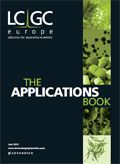Extraction of Vitamin D Metabolites from Human Serum Using Supported Liquid Extraction
Biotage Application Note
This application note describes a simple and effective procedure for the extraction of 25-OH vitamin D2 and 25OH vitamin D3 from human serum, using ISOLUTE SLE+ supported liquid extraction plates, with analysis by LC–MS–MS. The procedure incorporates an integral protein binding disruption step which eliminates the need for any offline protein disruption. Supported liquid extraction is a simple, high throughput alternative to traditional liquidliquid extraction for bioanalytical fluid samples, providing high analyte recovery, clean extracts and reduced sample preparation time.
Extraction Conditions
Sample pre-treatment: Dilute human serum (150 µL) with water:isopropanol (50:50, v/v, 150 uL). Cap and shake for 1 min.
Sample load: Load pre-treated serum (300 µL in total) onto the ISOLUTE SLE+ extraction plate (part number 8200400-P01). Pulse vacuum to initiate flow, then leave sample to absorb for 5 min.
Analyte elution: Apply heptane (750 µL) and wait 5 min for the solvent to absorb. Apply a second aliquot of heptanes (750 µL), allow to soak for a further 5 min, then apply a final pulse of vacuum.
Post extraction: Evaporate to dryness at room temperature and re-constitute ininjection solvent (mobile phase A: mobile phase B, 70:30, v/v, 100 µL,). Cap and vortex gently for 60 s.
Note: analytes are light sensitive and so amber glassware is recommended.
Analytical Conditions
Instrument: Waters Acquity UPLC with 20 µL injection loop interfaced to Premier XE triple quadrupole mass spectrometer equipped with an electro spray interface for mass analysis.
Column: Restek Pinnacle DB Biphenyl (1.9 µ, 50 + 2.1 mm i.d.)
Mobile phase: Isocratic 20%A: 80% B at 0.4 mL/min. Totalrun time 2.0 min.
A: 2 mM Ammonium Formate (aq) with 0.1% formic acid
B: 2 mM Ammonium Formate (99% MeOH 1% aq) with 0.1% formic acid
Injection volume: 15 µL (partial loop with overfill)
Sample temp: 10 °C
Column temp: 40 °C
Desolvation temp: 450 °C
Source temp: 120 °C
For full MRM conditions please see AN757 at www.biotage.com/applications
Results
Recoveries of > 90% were achieved for all analytes, with relative standard deviation (RSD) < 10%. Limit of quantifications (LOQs) were 3.75 ng/mL for 25-hydroxyvitamin D2 and 1 ng/mL for 25-hydroxyvitamin D3. Excellent linearity (> 0.99) for both analytes was demonstrated (see Figure 1). DEQAS samples extracted using this method showed excellent correlation with nominal values.

Figure 1: Calibration curve for 25-OH Vitamin D3 from serum
Conclusions
Supported liquid extraction using ISOLUTE SLE+ plates provides a simple, robust sample preparation method for extraction of Vitamin D metabolites from serum. The integral sample pre-treatment step is sufficient to eliminate analyte-protein binding, without any offline steps being required, leading to accurate determination of the analytes in serum samples.
Biotage AB
Kungsgatan 76, SE-753, 18, Uppsala, Sweden
Tel. +46 18 56 59 00 fax +46 18 59 19 22
Email:info@biotage.comWebsite:www.biotage.com
References
(1) For complete details of this application, see Application Note AN757, available from www.biotage.com/applications

New Method Explored for the Detection of CECs in Crops Irrigated with Contaminated Water
April 30th 2025This new study presents a validated QuEChERS–LC-MS/MS method for detecting eight persistent, mobile, and toxic substances in escarole, tomatoes, and tomato leaves irrigated with contaminated water.
University of Tasmania Researchers Explore Haloacetic Acid Determiniation in Water with capLC–MS
April 29th 2025Haloacetic acid detection has become important when analyzing drinking and swimming pool water. University of Tasmania researchers have begun applying capillary liquid chromatography as a means of detecting these substances.

.png&w=3840&q=75)

.png&w=3840&q=75)



.png&w=3840&q=75)



.png&w=3840&q=75)

















